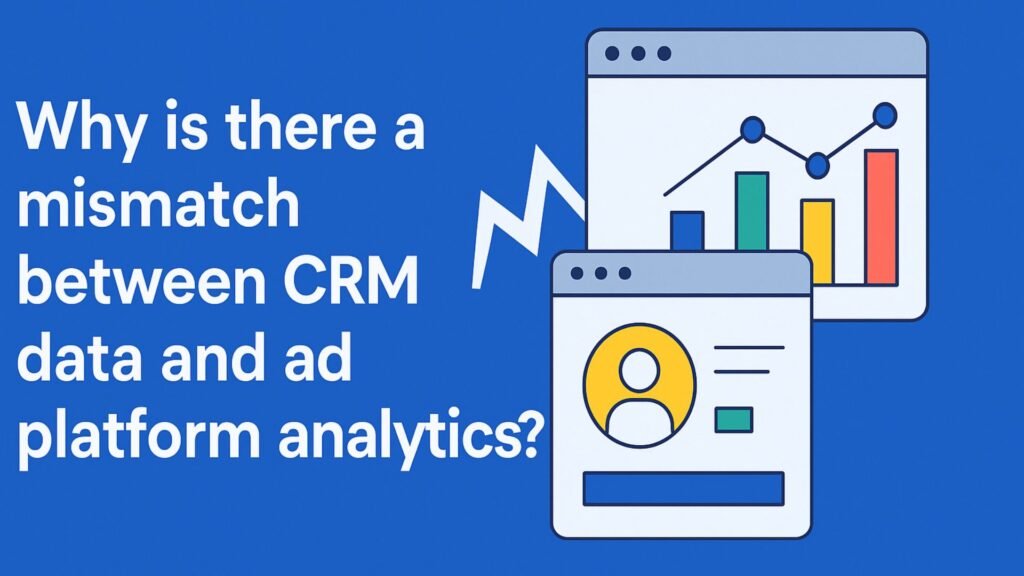CRM and ad platform data rarely match 100%—and that’s normal. The mismatch often comes from attribution differences, tracking limitations, ad blockers, and data sync delays. Let’s dive into why it happens and how to make both systems work together better.

Understanding the Mismatch
Seeing different numbers between your CRM (like HubSpot, Salesforce, Zoho) and ad platforms (like Facebook Ads, Google Ads, or LinkedIn) can be frustrating. You might ask:
- Why does Facebook say 50 leads, but my CRM only shows 35?
- Why is the cost per lead (CPL) so different in Ads vs. CRM?
- Who’s right—my CRM or my ad dashboard?
The short answer: both are right, but they’re measuring different things in different ways. Here’s what that means.
How Do CRMs and Ad Platforms Track Data?
Understanding how data is collected on both sides is step one:
- Ad platforms track impressions, clicks, and conversions using cookies, pixels, or server-side APIs. Their goal is to attribute success to their ads, often using flexible attribution windows.
- CRMs capture form submissions, chats, emails, and sometimes ad tracking data—but often rely on UTM parameters or manual inputs.
Since the tracking sources, timing, and logic differ, inconsistencies are inevitable.
Top Reasons for Data Mismatch (with Fixes)
1. Attribution Model Differences
Ad platforms often use view-through or click-through attribution across multiple-day windows (e.g., Facebook’s 7-day click, 1-day view). CRMs only track users after an actual form is submitted.
Example:
A person clicks your ad today but submits a form 5 days later from a direct visit.
- CRM sees “Direct”.
- Meta Ads claims it as a conversion.
Fix: Use first-click and last-click fields in your CRM. Use multi-touch attribution tools like HubSpot attribution, Wicked Reports, or Triple Whale if needed.
2. Missing or Stripped UTM Parameters
If your UTM parameters are not passed into form submissions or get stripped by redirects, your CRM will miss the original source.
Causes:
- Form platforms that don’t auto-capture URL params.
- Mobile redirect issues (especially in Facebook or LinkedIn in-app browsers).
- Broken or misconfigured UTMs.
Fix:
- Use hidden fields in forms to capture UTMs.
- Test end-to-end flows with tools like Google’s Tag Assistant.
- Use dynamic UTM templates for ad URLs.
3. Form Platform Not Connected Properly
If your form platform (like Elementor, Webflow, Typeform, ClickFunnels) isn’t integrated correctly with your CRM, the lead may not sync at all.
Fix:
- Test forms regularly.
- Use tools like Zapier, Make, or native integrations.
- Log webhook errors and email alerts for failed submissions.
4. Duplicate or Spam Leads Filtered by CRM
Your CRM may automatically filter spam, bots, or duplicate entries. The ad platform, however, will still count these clicks or form completions.
Fix:
- Use CAPTCHA, honeypot fields, or phone verification to reduce junk.
- Review CRM lead filtering rules to see what’s being excluded.
- Store unqualified/spam leads in a separate CRM list to cross-check.
5. Consent or Cookie Issues (Especially in Europe/CA)
GDPR, CCPA, and cookie banners prevent users from being tracked if they don’t opt in.
Result:
- CRM records the form fill.
- Pixel-based ad platforms see nothing.
Fix:
- Use server-side tracking (e.g., Facebook Conversion API, GTM Server Container).
- Sync events using offline conversions upload if needed.
6. Delayed Data Syncs or Reporting Lags
Ad platforms update conversion metrics at different times. CRMs might sync leads every 15 minutes—or instantly. If you’re comparing data in real-time, it’s rarely aligned.
Fix:
- Wait at least 24 hours before reconciling CRM vs ad data.
- Align time zones between platforms (e.g., UTC vs EST).
7. Form Resubmissions or Returning Visitors
A single user might click your ad and fill out the form multiple times, or revisit via different sources.
- Ad platform may count 1 conversion.
- CRM might log 2 leads or overwrite source fields.
Fix:
- Set up deduplication rules in your CRM.
- Capture original source in a separate, locked field.
8. Differences in Lead Definitions
Your CRM may only count qualified leads, while ad platforms count every form fill, including incomplete or disqualified submissions.
Fix:
- Define lead stages clearly (MQL, SQL, raw).
- Sync events like MQL stage changes back to the ad platform via offline conversions.
9. Ad Blockers and Privacy Extensions
Up to 30% of internet users use ad blockers or tracking prevention tools (like iOS’s ITP). These block analytics scripts and pixels from firing.
Fix:
- Implement server-side tracking.
- Use first-party cookies where possible.
- Accept that 100% match is unlikely.
10. Human Error in Setup or Analysis
Sometimes the problem is simply a misconfigured tag, broken integration, or a misinterpreted report.
Fix:
- Double-check UTM parameters
- Validate tracking tags with browser tools
- Involve both marketing and sales ops teams in audits
Example Scenario
Situation:
You run a Facebook Lead Gen Ad. Meta shows 84 leads. Your CRM shows 61.
Breakdown:
- 10 were filtered as duplicates (same phone number)
- 6 were missing UTM parameters (came in as “direct”)
- 7 were test or spam submissions
Solution:
Once UTM capture and deduplication were fixed, the discrepancy reduced to just 2 leads, matching 97% of data across systems.
Best Practices to Minimize Mismatch
| Task | Tool / Strategy |
|---|---|
| Capture UTMs | Hidden form fields, GTM, or JavaScript |
| Prevent duplicate leads | CRM rules, phone/email validation |
| Improve attribution | Multi-touch CRM fields, offline conversion imports |
| Sync lead status to ads | Zapier, Meta Conversions API, Google Offline Conversions |
| Track click-to-CRM flow | Google Analytics, Facebook Test Events Tool |
| Review time zones | For blogs, ads, or social media |
How Socinova Can Help?
At Socinova, we specialize in streamlining your marketing data so ads, forms, and CRMs talk to each other properly.
Whether it’s troubleshooting mismatched leads or implementing server-side tracking, we’ll help you fix attribution problems from the ground up.
Need cleaner, reliable data between ads and CRM? Talk to our team.
Final Thoughts
A mismatch between CRM data and ad platform analytics is common—but solvable.
The key is to understand how each system tracks data, make your lead flow airtight, and reconcile differences with proper attribution tools.
Perfect alignment is rare—but with the right setup, you can close the gap and make confident decisions.




